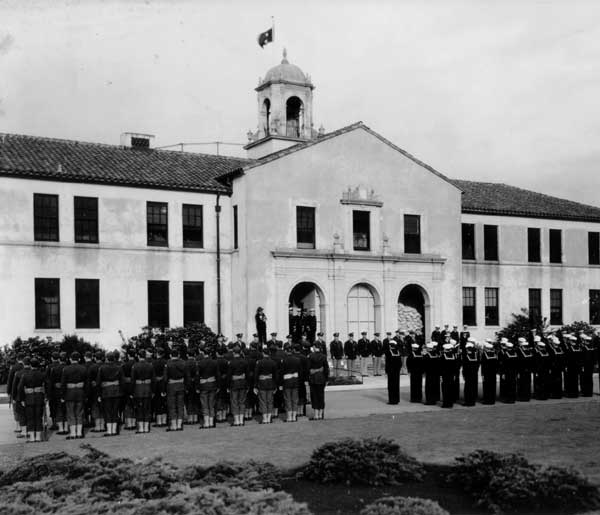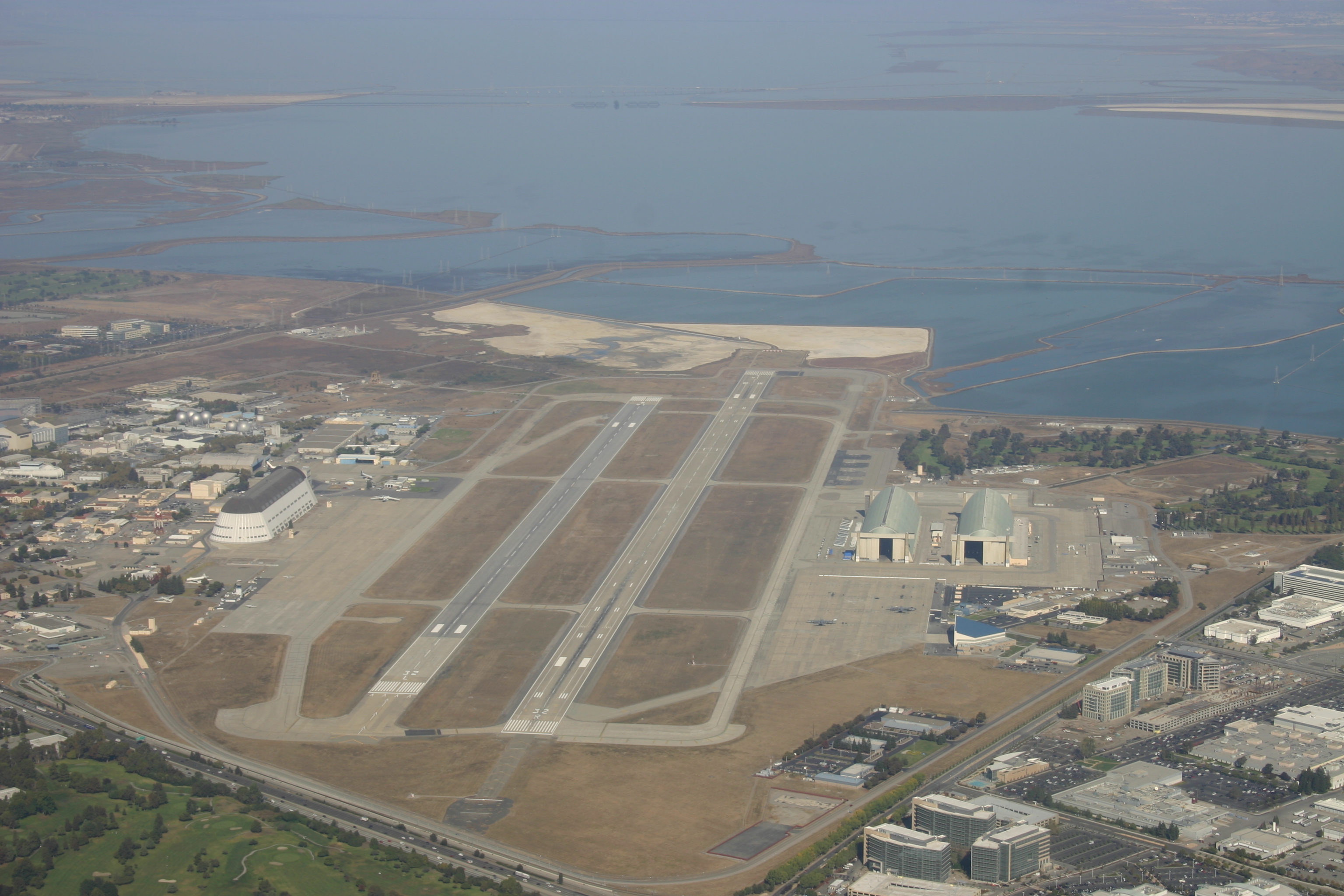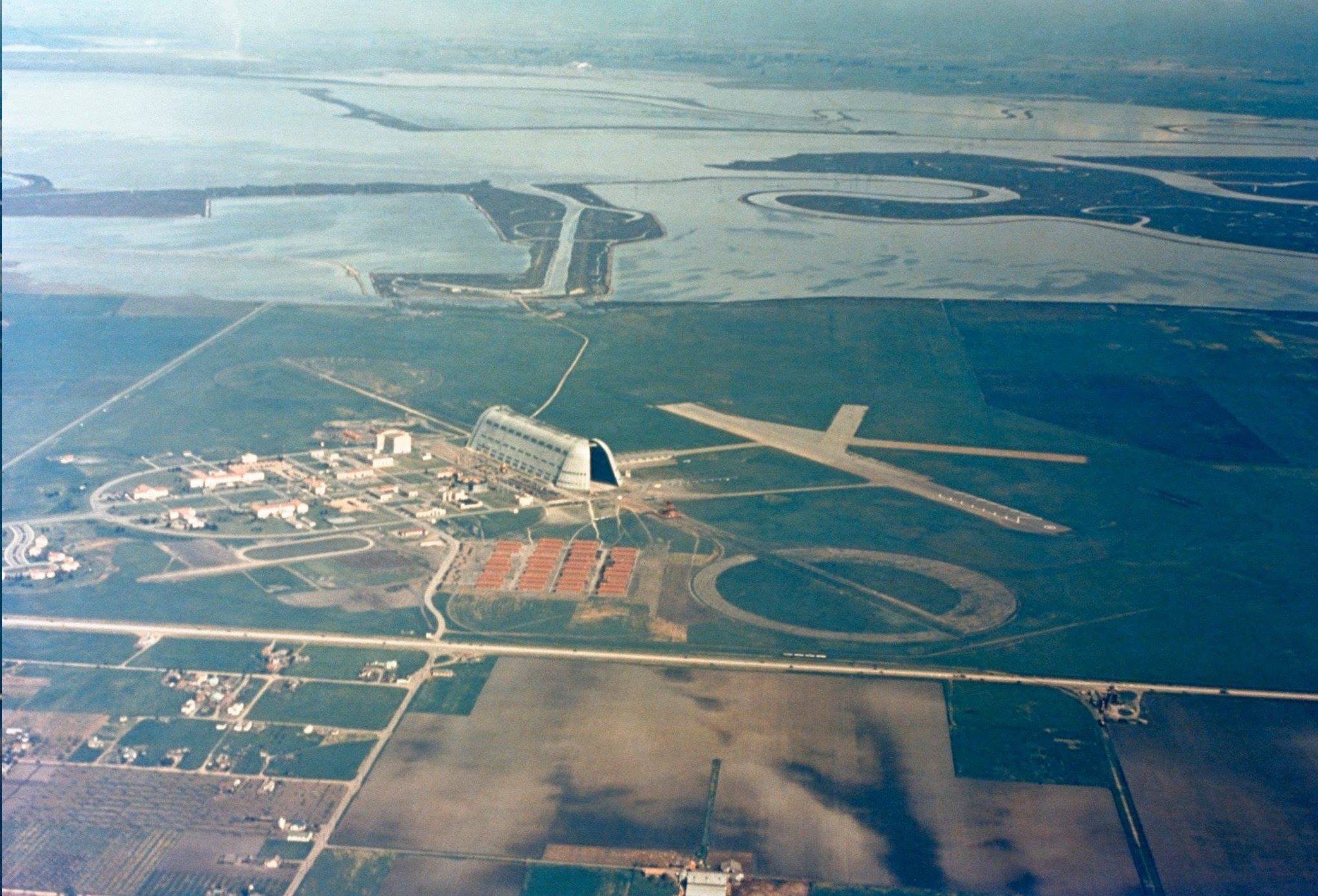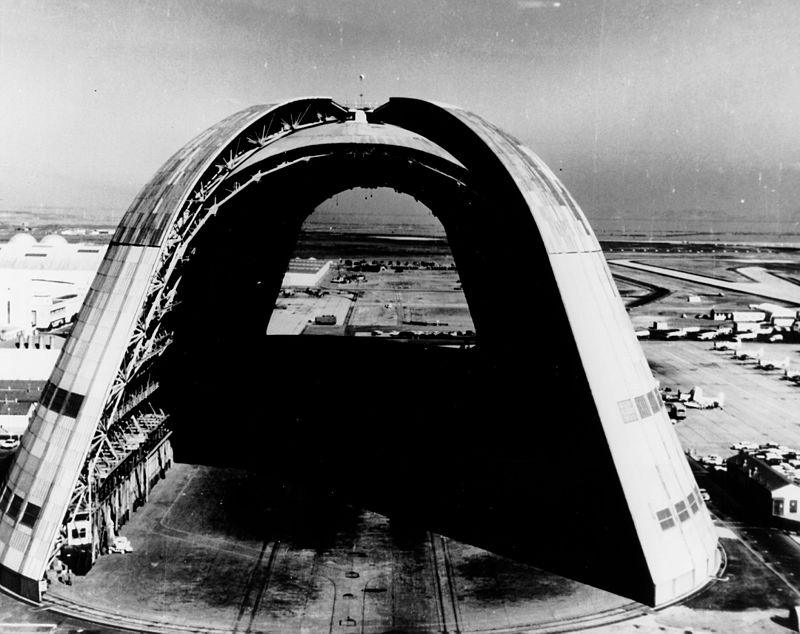

In July 1935, VB-2, VF-6, VT-2, and VS-2 operated from Moffett on a trial basis. A proposal then surfaced for the Navy to trade Moffett to the Army in exchange for North Island, California; Bolling Field, Washington, D.C.; and Ford Island, Hawaii. Although the Army opposed the deal, President Roosevelt, nevertheless, ordered the trade. The Army definitely felt shortchanged by the President, considering him an "old Navy man" -- in fact, Roosevelt served as Assistant Secretary of the Navy from 1913 to 1920. The Army took over Moffett in September 1935, and immediately became disenchanted with it, mainly due to the high cost of Hangar One's maintenance. The Army attempted to quit the station, but President Roosevelt would not permit abandonment so the Army remained. Moffett eventually became headquarters of the Army's Western Flying Training Command. In 1939, the Ames Aeronautical Laboratory established. After Pearl Harbor, the Navy desperately needed Moffett back to start West Coast blimp operations. The Army had grown fond of Moffett (probably because the Navy wanted it) and resisted the transfer; however, Washington overruled once again ordering the Army to vacate the base.
The Navy commissioned ZP-32 at Moffett in January, but the squadron had no blimps. Two ex Army ships, TC-13 and TC-14, had been given to the Navy when the Army abandoned its LTA program in 1937. In January 1942, the deflated blimps, in storage at Lakehurst, were shipped by rail to Moffett and inflated. On February 4, 1942, ZP-32 conducted its first flight. During March and April, Moffett added three L-ships appropriated from Goodyear's advertising fleet. On April 16, the Navy recommissioned the station. The next month, the last Army aircraft finally departed as the headquarters of the Western Flying Training Command moved to Orange County Airport at Santa Ana. Goodyear then began a program to ship new deflated blimps from Akron, Ohio to Moffett for final assembly and inflation. The Navy placed the first airship completed by this program, K-20, in service on October 31. In November, construction began on Hangars Two and Three.
Meanwhile, in October 1942, the first cadets arrived for blimp flight training. During the war, LTA and HTA flight training were completely separate - Navy blimp pilots were not qualified to fly an aircraft as they were after the war. Prospective blimp pilots were recruited directly from pre-flight schools -- some were former LTA enlisted men. The fact that blimp training only lasted four months, may have motivated some cadets to volunteer. Moffett conducted primary training to relieve the load on Lakehurst. Initially, cadets worked as ground crew men to learn blimp-handling procedures. A few flights in hydrogen-filled free balloons followed before training in L-ships began. After completing primary, the cadets traveled to Lakehurst for advanced training in K-ships. Blimp flight training later extended to six months.
Moffett was the center for West Coast LTA operations and headquarters for the Commander, Fleet Airships Pacific. Blimp Headquarters Squadron Three also formed at Moffett to provide support for ZP-32. Late in 1942, two additional West Coast LTA stations commissioned at Santa Ana, California and Tillamook, Oregon. On August 6, 1943, Moffett opened two small NAAFs at Watsonville and Eureka, California to provide more patrol coverage of the Pacific coast, north and south of Moffett. Limited HTA operations began at Moffett in December by utility squadron VJ-14.
By the beginning of 1944, the Navy began to scale down on LTA operations -- especially on the West Coast where Japanese submarines had never become a serious threat. In March 1944, primary blimp flight training ended. As a result, Moffett was designated a joint LTA/HTA station. In June, VJ-18 commissioned and was trained by VJ-14. That same month, the Ames Lab dedicated a wind tunnel. In July, VPB squadrons of PV-1 Venturas with Patrol Service Unit 8 - Detachment 2 arrived as VJ-14 transferred. At the end of 1944, four VPB squadrons with a total of 53 PVs plus two utility squadrons, VJ 1 with a mixed bag of aircraft and VJ-18 with nine Martin JM towplanes were on board. Meanwhile, Goodyear's assembly program at Moffett ended after delivering 39 L, G, and K-ships.
During 1945, VPB squadrons received the new PV-2 Harpoons. The Antisubmarine Warfare Training Unit - Moffett formed with 13 aircraft including 10 OS2U Kingfishers. In June, the first M-ship, the largest blimp in Naval service, arrived. The Navy decided to move VR-4 to Moffett from Oakland and a $2.5 million contract began to strengthen the taxi ways. The Ames Aeronautical Laboratory continued to grow and by the end of the war, 11 Navy aircraft, including the Ryan FR-1 Fireball, were assigned to that activity.
Moffett had a 7000-ft. runway that was part of a 1.14 million sq. yd. asphalt mat with eight mooring circles. Barracks existed for 290 officers and 2,500 enlisted men. The base employed almost 1000 civilians, mostly in the Assembly and Repair Department. In June 1945, the Army transferred the former interceptor field at Half Moon Bay to Moffett for an OLF.
Following the war, Moffett became the West Coast center for NATS and later for the Navy contribution to MATS (still later MAC). Blimp operations ended forever at Moffett in August 1947. The Navy then based carrier squadrons at Moffett and in 1953 designated the station the Navy's first Master Jet Base. Continued urban growth doomed jet operations at Moffett and in the late 1950s, the jet squadrons moved to Miramar, although the Douglas AD Skyraiders remained. In January 1963, Moffett was chosen as the West Coast center for the new Lockheed P-3 Orion. In 1967, VR-7 decommissioned, ending Navy participation in MAC. At its height, P-3 operations totaled nine squadrons - seven operational, one training, and one reserve.
As a result of the 1991 Base Realignment
and Closure Commission's decision, NAS Moffett closed on June
1, 1994, becoming the Moffett Federal Airfield. Moffett's P-3
active duty assets moved to Whidbey Island. The remaining Navy
command is now the Naval Air Reserve - Santa Clara. The reserve
P-3 squadron, VP-91; Fleet Logistics Reserve Squadron 55 with
KC-130Ts; and non-flying reserve units were present until1999.
NASA's Ames Research Facility administers the airfield and has
also taken over ALF Crow's Landing.
Copied with the permission of the author from United States Naval Air Stations of World War II.

Located in Santa Clara County, California, near the southern tip of San Francisco Bay, MFA encompasses approximately 2,200 acres. It is bordered on the north by salt evaporation ponds which are adjacent to San Francisco Bay, on the west by Stevens Creek and NASA's Ames Research Facility, on the south by Highway 101, and on the east by the Lockheed Aerospace Center. MFA is surrounded by a security fence, and access is limited to personnel, residents, and authorized visitors. Although the NASA-Ames property is distinct from the Moffett Federal Airfield property, NASA-Ames is located within the Moffett Field perimeter security fence.)
MFA is divided in half by the runway system which extends almost the length of the property. Most of the aircraft and flight training operations take place on the east side of the runway and administrative activities and base housing are located on the west side. The 2,263-acre site has two parallel runways separated by 625 feet and fully instrumented. One is 9,200 feet long and 200 feet wide; the other is 8,124 feet long (7,517 feet with displaced threshold) and 200 feet wide. There are four aircraft maintenance hangars and 472,300 square yards of aircraft parking apron.
The cities of Sunnyvale and Mountain View surround Moffett Field. Land use in the vicinity of MFA is urban/suburban; the cities of Mountain View and Sunnyvale are home to numerous industries including electronics, high tech, and aerospace firms. This area is part of the well-known Silicon Valley.
Prior to its closure, Naval Air Station Moffett Field employed more than 5,500 military, 1,500 civilian, and 1,000 reservist personnel. As of 1998 MFA employed about 1,000 federal employees, 780 military personnel, 2,200 reservists, and 250 contractors.
The 1,000-acre site for the air base was purchased by Bay Area communities and sold to the military in 1931 for one dollar. It was originally commissioned as NAS Sunnyvale in 1933 to serve as a base for the West Coast dirigibles of the Navy's lighter-than-air program. Moffett Field was built to house the biggest aircraft of its day: the USS Macon, a 239-meter (785-foot) long dirigible that arrived at Moffett Field for the first time in 1933. To house it, the Navy built the massive Hangar 1, one of the best-known landmarks in the Bay Area. The Macon was intended to provide long-range reconnaissance for the Pacific Fleet, but it flew only eight missions before it crashed off the coast of Monterey in 1935. Soon after the airship Macon was lost, the base was transferred to the Army Air Corps.
Later, the National Advisory Committee for Aeronautics (NACA) established what would eventually become NASA Ames Research Center on 62 acres adjacent to the Naval Air Station. Moffett Field became a major center for the development and testing of new aviation and flight-related technology. Congress originally established Ames Research Center in 1939 as the Ames Aeronautical Laboratory under the National Advisory Committee for Aeronautics (NASA’s predecessor).
In 1942, the base was transferred back to the Navy and renamed NAS Moffett Field. The landing field at NAS Sunnyvale was named "Moffett Field," in honor of RAdm. W.A. Moffett who had died in the crash of the USS Macon's sister ship, USS Akron. It was the Navy's practice (as it is now) to name the landing fields at their air stations (which are normally named for places) for individuals, who have by virtue of heroism or significant contribution, furthered Naval Aviation in some manner. So, "Moffett Field" became the landing field at NAS Sunnyvale.
After the attack on Pearl Harbor, the military decided it needed aircraft to patrol the Pacific for submarines and mines, and the Navy responded by restarting the lighter-than-air project with smaller blimps only 75 meters (246 feet) in length. Even Hangar 1 was insufficient to house all the activity around the revitalized lighter-than-air reconnaissance project. In 1942, two more huge hangars were constructed in record time, primarily out of wood and concrete because of war-time shortages of steel. As many as 20 blimps at a time were on duty at the base during the war years, and Moffett Field had an excellent record of ship and mine detection. But as jet airplanes were developed and began to take over the functions of the blimps, the lighter-than-air program went into decline. In 1947, the last blimp at Moffett Field was deflated. The era of lighter-than-air ships was over.
In 1958, Congress created NASA with the National Aeronautics and Space Act of 1958. The Ames Aeronautical Laboratory was renamed Ames Research Center and became a NASA field center. Over the years, Ames Research Center used its laboratories and wind tunnels to test dozens of propulsion systems and airplane designs. As the coalition of Bay Areas counties predicted when it lobbied for the creation of Moffett Field in the late 1920's, the base’s research program and facilities catalyzed the development of numerous private technology and aerospace corporations, among them Hiller Aircraft Corporation and Lockheed Martin.
During the 1950s and 1960s, NAS Moffett Field served as a major naval air transport base. In 1962 the Navy was relocating Moffett's jet squadrons to a new air station at Lemoore, in a remote section of the San Joaquin Valley. There was much speculation as to the future of Moffett Field. Then came the announcement that Moffett Field was selected as the site of introduction on the west coast for the Navy's newest, fastest and most effective submarine hunter-killer aircraft, the P-3V Orion. Moffett Field returned to its original mission of long-range reconnaissance and anti-submarine patrols with the arrival of the Navy’s newest anti-submarine aircraft: the P-3 “Orion.” By 1973, aircraft based at Moffett Field were responsible for patrolling approximately 241 million square kilometers (93 million square miles) of the Pacific Ocean, an area stretching from the coast of Alaska to Hawaii.
After a station reorganization in 1973, the mission of NAS Moffett Field was to support antisubmarine warfare training and patrol squadrons. During this mission, only unit-level and intermediate-level aircraft maintenance was performed. In 1992, the base was designated for closure under the Department of Defense Base Realignment and Closure (BRAC) program. Moffett Field was closed as a military base on July 1, 1994.
In July 1994, NASA, which owns the adjacent Ames Research Center, assumed control of the NAS Moffett Field facility and changed its name to Moffett Federal Airfield. Supervision of Moffett's two runways, three aircraft hangars, and 3.5 million square feet of facilities was turned over to NASA Ames Research Center. As the new federal custodian, NASA Ames now operates the shared federal facility known as Moffett Federal Airfield. Ames is located on the border of the cities of Mountain View and Sunnyvale in northern California, in the heart of "Silicon Valley" at the southern end of San Francisco Bay. Ames occupies about 430 acres of land, and serves as host to a number of other federal, civilian, and military resident agencies on the adjoining 1,500-acre former naval air station, now known as Moffett Federal Airfield.
NASA took over administration of 752 hectares (1,857 acres) of Moffett Field in 1994. The immediate issues were how to use the newly acquired land in a manner consistent with NASA’s mission, and how to pay for the maintenance and operations of such a large site. These matters were originally addressed in the Moffett Field Comprehensive Use Plan (CUP) and its associated Evironmental Assessment (EA), which resulted in a Finding of No Significant Impact (FONSI) in 1994.
In 1995, the city of San Jose passed a resolution stating that if the federal government decided to discontinue its operation of Moffett Airfield, the airfield should become a civil airport for the long-term benefit of the Santa Clara County.
After transfer of the property, local Mountain View and Sunnyvale community leaders formed a Community Action Committee (CAC) in 1997, to recommend uses at Moffett Field.
In June 1997 the CAC completed six months of comprehensive public deliberations on the future of Moffett Federal Airfield and a thorough review of practical alternatives for retaining NASA Ames Research Center as the operator of the federal facilities there.
The Sunnyvale City Council in October 1997 agreed in principle to participate with the City of Mountain View and NASA to explore the development of a major air and space center located at Moffett and Ames similar to those established in Washington, D.C., Huntsville Alabama, and Cape Canaveral, Florida.
The Civil Reserve program would allow the federal government to use the cargo planes in case of an emergency in exchange for allowing commercial use of military bases or other nonmilitary facilities approved by Congress. Air cargo at Moffett Field under the federal Civil Reserve Air Fleet program is unacceptable to the City of Sunnyvale, according to the decision made by Sunnyvale City Council at its meeting on November 25, 1997. The Council's decision was based on the report and recommendations of the Sunnyvale / Mountain View Joint Community Advisory Committee (CAC) on Moffett Federal Airfield after a series of extensive public hearings on issues related to the future of Moffett Federal Airfield and NASA Ames Research Center. Residents' primary concerns have included noise levels of the proposed air cargo planes.
The CAC worked closely with NASA and made its recommendations to the two cities. NASA’s goal is to develop portions of Moffett Field into the NASA Research Park (NRP), a world-class, shared-use research and development campus in association with academia, industry and non-profit organizations.
The NASA Ames Development Plan (NADP) details the transformation of the original 200-hectare (500-acre) campus of NASA Ames Research Center and the 600 hectares (1,500 acres) of the former Naval Air Station Moffett Field into an integrated, dynamic research and education community in the heart of Silicon Valley. This transformation will be led by the establishment of the NASA Research Park, a 86-hectare (213-acre) research and development campus for partners from academia, industry and non-profit corporations with shared goals in support of NASA's mission.
At Moffett Federal Airfield, the 129th Rescue Group (RQG) provides manpower for the airfields crash, fire and rescue, air traffic control, and security police services, and pays a portion of the total associated costs. The ANG also pays a share of other base operating support costs. These costs to the ANG have risen significantly since NAS Moffett realigned to Moffett Federal Airfield, and can be avoided if the unit is moved to an active duty airfield.
Community officials were concerned about the future viability of Moffett Federal Airfield, in light of the critical airfield services the 129th Rescue Group provides. Relocation of the unit would force National Aeronautical Space Administration (NASA)-Ames Research Center to replace those services, possibly at a higher cost. These costs would be passed onto NASA-Ames in continuing to operate Moffett Federal Airfield. The community believes higher costs could make it difficult for NASA-Ames to attract and retain tenants at the airfield.
Community officials believed the Air Forces analysis was flawed because the analysis did not consider costs that would be passed on to NASA. They assert that costs and savings should be calculated government-wide and not just DoD-wide. Finally, the community asserted that this recommendation should not have been submitted to the Commission for review because, the Guard Station did not meet the 300 civilian threshold required for recommendations to be submitted to the Commission.
The DoD recommendation on Moffett Federal Airfield AGS directed the unit to relocate to McClellan AFB, California. Because the Commission recommends closure of McClellan AFB, the DoD recommendation can not be implemented. Given the cost associated with relocating the unit to another Air Force base, the Commission found the Guard Station and unit should remain at Moffett Federal Airfield.
The 1995 BRAC Commission recommended that Moffett Federal Airfield Air Guard Station remain open.
In 1999 the US House of Representatives Military Construction Appropriations Subcommittee approved $14 million to construct the new composite maintenance hangar at Moffett Federal Airfield in Mountain View for the 129th Rescue Wing of the California Air National Guard. In an effort to get the Air National Guard to stay on site, the city of Sunnyvale played a major role in helping to get the funding approved.

Moffett Community Housing
Even after all of the base closures, there remains a population of some 1,400 military families in the San Francisco Bay Area. This community includes recruiters, ROTC instructors, servicemembers in graduate school, active duty servicemembers in reserve units, and small commands like South Pacific Division and San Francisco District. And nearly 1,800 are assigned to Coast Guard units in the San Francisco Bay Area.
By 1999, the only housing for military families was 306 units at the Presidio made available by the National Park Service under a permit, 292 units at the Naval Weapons Station Concord, and the 803 housing units under Air Force control at Moffett Field.
But even this housing had an uncertain future. The permit for the 306 units at the Presidio would expire on Sept. 30, 2000, and the Presidio Trust was under a legislative mandate to get fair market value for the housing. BRAC '95 had directed the realignment of Onizuka Air Force Station, custodian of the 803 housing units at Moffett Field, and directed the disposal of the housing units. As 2000 drew to a close, the Navy announced its intentions to close the 292 housing units at Concord. And military families faced the specter of living "on the economy" in the highest-cost housing market in the U.S.
In late 1998, the Air Force "screened" the so-called Moffett housing for interest by other DoD and civilian federal agencies. NASA Ames had a plan to develop partnerships with incubator, high-tech businesses, and to develop a business park at NASA Ames. The Air Force housing would provide affordable housing to entice incubator businesses to NASA Ames, so NASA requested the property from the Air Force.
Seeing the passing of an opportunity to partially satisfy the housing needs of military families in the San Francisco Bay Area, the South Pacific Division (SPD) commander solicited the support of the Army staff, including the Army Chief of Staff, to acquire the housing from the Air Force.
Because the Army, like many of the services, was divesting itself of housing (primarily through privatization), acquiring the Moffett Housing was swimming against the current. To the credit of Army leadership, the SPD commander received the support that he sought, and the Army formally requested transfer of the housing.
In April 2000, the Assistant Secretary of the Air Force approved the transfer, and in July the housing formally transferred to the Army, which renamed it Moffett Community Housing.
The housing is under administrative control of the U.S. Army Forces Command (FORSCOM); real property accountability is vested in Fort McCoy. SPD is FORSCOM's executive agent for operations and management of the housing. Most significantly, that housing was now available to all servicemembers.
To ensure a smooth transfer of the housing operation from the Air Force to the Army, and to ensure sound management of the housing, SPD chartered a Project Delivery Team and established command and control.
Copied with permission from globalsecurity.com

|
|
|
|
| US Army Order of Battle 1919-1941 | 1935-1941 |
|
| US Army Order of Battle 1919-1941 | 1936-1940 |
|
| US Army Order of Battle 1919-1941 | 1937-1940 |
|
| US Army Order of Battle 1919-1941 | 1939-1940 |
|
| US Army Order of Battle 1919-1941 | 1940 |
|
| US Army Order of Battle 1919-1941 | 1940-1941 |
|
| 7 December 1941 |
|
Additional Online Histories